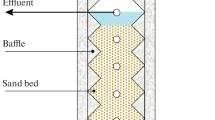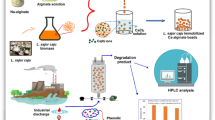Abstract
A defined mixed culture ofPseudomonas putida, Commamonas testosteroni andCandida tropicalis was immobilized by adsorption on polyurethane foam, cocoa-fibers, expanded slate and sintered glass. Packed bed reactors were used for long-term continuous phenol biodegradations. Loading experiments were done to study the impact of the following parameters: (1) hydraulic retention time, (2) dissolved oxygen concentration, and (3) elimination of the oxygen limitation. After the acclimation period (≈10 d), the loading test with the individual packings showed the following maximum degradation rates: sintered glass 34, polyurethane foam 12, expanded slate 11.5, and cocoa-fibers 7.7 kg m−3 d−1. All these values were reached at a removal efficiency >99 % and with oxygen in excess. Under these conditions, the pH of the diluted unbuffered medium in the reactor effluent was 3.2–4.0 and no incompletely oxidized metabolic intermediates were found. The free cell concentration in the effluent increased after the phenol overloading time period.
Similar content being viewed by others
Abbreviations
- c in :
-
inlet phenol concentration, mg/L
- c out :
-
outlet phenol concentration, mg/L
- DOC:
-
dissolved oxygen concentration, %
- FBR:
-
fluidized bed reactor
- HRT:
-
hydraulic retention time, min
- MM:
-
mineral medium
- OL:
-
organic loading, mg L−1 h−1
- PBR:
-
packed bed reactor
- pHout :
-
pH of the medium outlet
- PUF:
-
polyurethane foam
- Q :
-
water flow rate, mL/min
- q S :
-
phenol degradation rate, mg L−1 h−1
- RE:
-
removal efficiency, %
- V L :
-
working volume of reactor, mL
References
Acuna M.E., Perez F., Auria R., Revah S.: Microbiological and kinetic aspect of a biofilter for the removal of toluence from waste gases.Biotechnol.Bioeng.63, 175–184 (1999).
Alexieva Z., Ivanova T., Godjevargova B., Atanasov B.: Degradation of some phenol derivatives byTrichosporon cutaneum R57.Process.Biochem.37, 1215–1219 (2002).
Annadurai G., Juang R.S., Lee D.J.: Microbiological degradation of phenol using mixed liquors ofPseudomonas putida and activated sludge.J.Waste Manag.22, 703–710 (2002).
Arquiaga M.C., Canter L.W., Robertson J.M.: Microbiological characterization of the biological treatment of aircraft paint stripping wastewater.Environ.Pollut.89, 189–195 (1995).
Bechard G., Bisaillon J.G., Beaudet R.: Degradation of phenol by a bacterial consortium under methanogenic conditions.Can.J.Microbiol.36, 573–578 (1990).
Bettmann H., Rehm H.J.: Degradation of phenol by polymer entrapped microorganisms.Appl.Microbiol.Biotechnol.20, 285–290 (1984).
Branyik T., Kuncová G., Páca J., Demnerová K.: Encapsulation of microbial cells into silica gel.J.Sol Gel Sci.Technol.13, 283–287 (1998).
Chen K.C., Lin Y.H., Chen W.H., Liu Y.C.: Degradation of phenol by PAA-immobilizedCandida tropicalis.Enzyme Microb.Technol.31, 490–497 (2002).
Chitra S., Sekaran G., Padmavathi S., Chandrakasan G.: Removal of phenolic compounds from wastewater using mutant strain ofPseudomonas pictorum.J.Gen.Appl.Microbiol.41, 229–237 (1995).
Ehrhardt H.M., Rehm H.J.: Phenol degradation by microorganisms adsorbed on activated carbon.Appl.Microbiol.Biotechnol.21, 32–36 (1985).
Eighmy T., Maratea D., Bishop P.: Electron microscopic examination of wastewater biofilm formation and structural components.Appl.Environ.Microbiol.45, 191–193 (1983).
Gallego A., Fortunato M.S., Foglia J., Rossi S., Gemini V., Gomez L., Gomez C.E., Higa L.E., Korol S.E.: Biodegradation and detoxication of phenolic compounds by pure and mixed indigenous cultures in aerobic reactors.Internat.Biodeter.Biodegrad.52, 261–267 (2003).
Gonzales G., Herrera M.T., Garcia M.T., Pena M.M.: Biodegradation of phenol in a continuous process: comparative study of stirred tank and fluidized bed reactor.Biores.Technol.76, 245–251 (2001).
Heipieper H.J., Keweloh H., Rehm H.J.: Influence of phenols on growth and membrane permeability of free and immobilizedEscherichia coli.Appl.Environ.Microbiol.57, 1213–1217 (1991).
Hinteregger C., Leitner R., Loidl M., Ferchi A., Streichsbier F.: Degradation of phenol and phenolic compounds byPseudomonas putida EKII.Appl.Microbiol.Biotechnol.37, 252–259 (1992).
Holladay D.W., Hancher C.W., Scott C.D., Chilcote D.D.: Biodegradation of phenolic waste liquors in stirred-tank, packed-bed and fluidized-bed bioreactors.J.Water Pollut.Control Fed.50, 2573–2589 (1978).
Hopp J., Huegele T.: Porositätsbestimmung von Biofiltermaterialien.Entsorgungs Praxis9, 40–42 (1996).
Lakhwala F.S., Goldberg B.S., Sofer S.S.: A comparative study of gel entrapped and membrane attached microbial reactors for biodegrading phenol.Bioproc.Eng.8, 9–18 (1992).
Mörsen A., Rehm H.J.: Degradation of phenol by mixed culture ofPseudomonas putida andCryptococcus elinovii adsorbed on activated carbon.Appl.Microbiol.Biotechnol.26, 283–288 (1987).
Mörsen A., Rehm H.J.: Degradation of phenol by a defined mixed culture immobilized by adsorption on activated carbon and sintered glass.Appl.Microbiol.Biotechnol.33, 206–212 (1990).
Oh J.S., Han Y.H.: Isolation and characterization of phenol degradingRhodococcus sp. DGUM 2011.Korean J.Appl.Microbiol. Biotechnol.25, 459–463 (1997).
Okaygun M.S., Green L.A., Akgerman A.: Effect of consecutive pulsing of an inhibitory substrate on biodegradation kinetics.Environ.Sci.Technol.26, 1746–1752 (1992).
Páca J., Komárková E., Prell A., Stiborová M., Sobotka M.: Kinetics of phenol oxidation byCandida tropicalis: effects of oxygen supply rate and nutrients on phenol inhibition.Folia Microbiol.47, 701–708 (2002).
Prieto M.B., Hidalgo A., Serra J.L., Llama M.J.: Degradation of phenol byRhodococcus erthropolis UPV-I immobilized on biolite in a packed-bed reactor.J.Biotechnol.97, 1–11 (2002).
Rigo M., Alegre R.M.: Isolation and selection of phenol-degrading microorganisms from industrial wastewaters and kinetics of the biodegradation.Folia Microbiol.49, 41–45 (2004).
Sa C.S.A., Boaventura R.A.R.: Biodegradation of phenol byPseudomonas putida DSM 548 in a trickling bed reactor.Appl.Microbiol.Biotechnol.9, 211–219 (2001).
Singer P.C., Pfaender F.K., Chincilli J., Lamb J.C.: Composition and biodegradability of organics in coal conversion wastewaters.Symp.Proc.Environ.Aspects Fuel Convers.Technol.3, 461–468 (1977).
Watanabe K., Hino S., Takahashi N.: Responses of activated sludge to an increase in phenol loading.J.Ferment.Bioeng.82, 522–524 (1996).
Young L.Y., Cerniglia C.E.:Microbial Transformation and Degradation of Toxic Organic Chemicals, pp. 27–64. Wiley-Liss, New York 1995.
Zache G., Rehm H.J.: Degradation of phenol by a co-immobilized entrapped mixed culture.Appl.Microbiol.Biotechnol.30, 426–432 (1989).
Author information
Authors and Affiliations
Corresponding author
Additional information
The work was supported by theCzech Science Foundation (project 104/03/0407).
Rights and permissions
About this article
Cite this article
Páca, J., Páca, J., Kostečková, A. et al. Continuous aerobic phenol degradation by defined mixed immobilized culture in packed bed reactors. Folia Microbiol 50, 301–308 (2005). https://doi.org/10.1007/BF02931410
Received:
Revised:
Issue Date:
DOI: https://doi.org/10.1007/BF02931410




